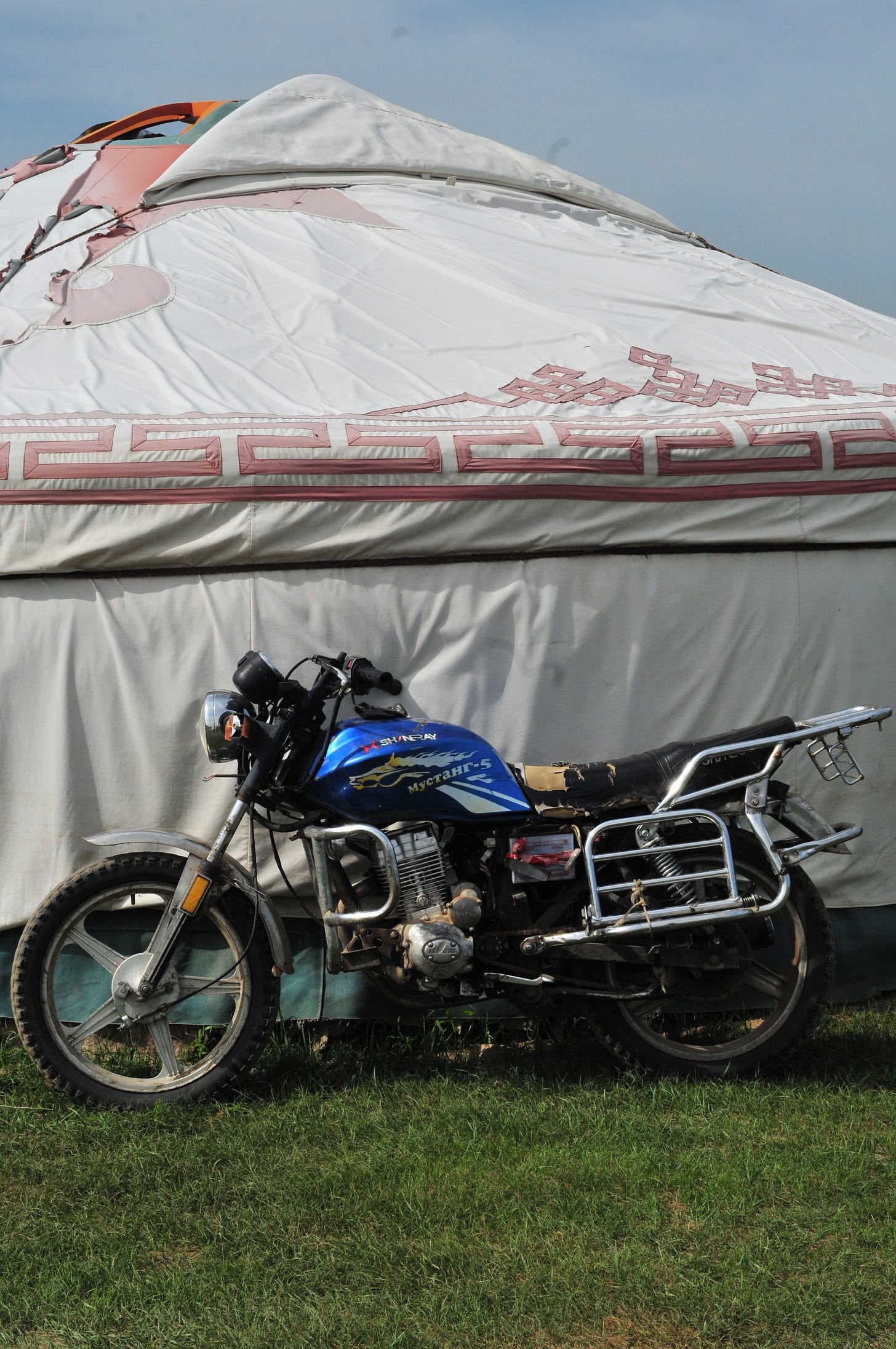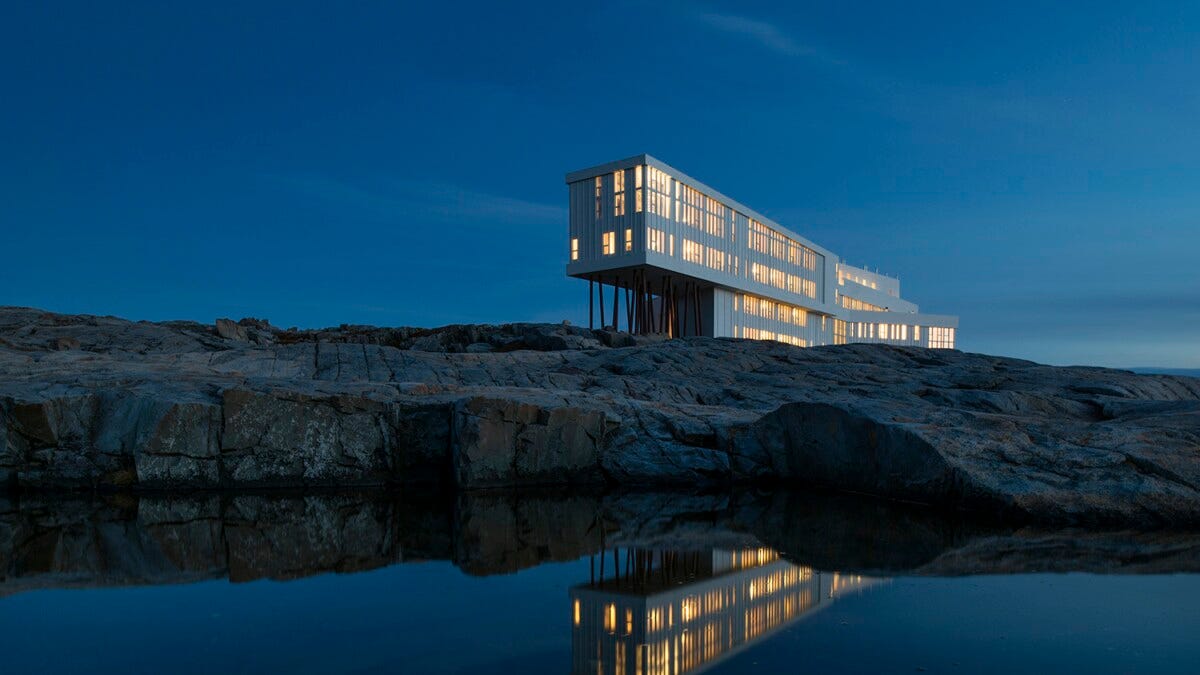"watch this in a yurt"
On word of mouth, the analog joy of secret concerts, how art can change the world, and Zita Cobb's trojan horse of ideas.
“If you go out and stand there looking around for worms, there are no worms. If you turn over a rock, you’re probably going to find worms. If you dig a little bit, you’re almost certainly going to find worms. So that’s what they were doing, they were coming and turning over rocks.”
-Zita Cobb talking about the National Film Board of Canada.
Zita likes to say she lived in three centuries. Until she was ten years old she lived in the 19th century, on an island off the coast of Newfoundland called Fogo. There was no running water, little currency- mostly barter, hardly any electricity. There were a handful of small, distinct, communities. Then the large boats came in and things moved fast, a product of trawlers and technology and Canada selling fishing rights. Going from hand line fishing to industrial quantities the cod quickly were fished out. The local economy was stunned so the communities on Fogo Island were moved to the mainland by law; infrastructure on the island was too difficult to maintain from the federal government's point of view. This was Zita living in the 20th century. Inspired to learn business in order to understand the demise of cod fish and community, she studied and grew. She then lived in the 21st century working in the emerging tech sector. Zita worked at JDS Fitel for ten years and became the CFO. The company merged with the U.S. company Uniphase in 1999 to become JDS Uniphase, a major manufacturer of fiber optic technology. Her life, from barter to fiber optics, is a life lived in a particular shift in the history of humanity.
Zita then left that business world, the world of growth and consumption, and she began a project back on Fogo Island, an economic experiment based on the ideas of E.F. Schumacher and his iconic classic book “Small is Beautiful.” Economics can glaze some over but even if you are not interested I urge you to notice Schumacher briefly in this National Film Board of Canada documentary short from the 1970’s: https://aeon.co/videos/bigger-isnt-better-the-renegade-buddhist-economics-of-e-f-schumacher
Schumacher liked simplicity in systems and structure. The way a spoon can not be improved upon, or an oar lock. Simple mechanics leaving the user with the value of the process, leaving one with purpose. In economics he wanted to recognize that companies and businesses are not served and grown by the people, rather the business serves the people and community, or at least can. That a community can be fed by a business and nourished rather than consumed, that it can serve a place rather than a place serve a business.
Culture is a human response to a place. Place shapes language, art and song. Weather patterns affect religions and ideas and culture is the way humaness presents place through its living. “Nature and culture are the two great garments of human life. Business and Technology are the two great tools that can and should serve them.” -Schumacher.
Zita wanted to build a business that served the place, that served Fogo Island. She wanted to go and create an economy that would nourish a place rather than extract from it. She created a social enterprise called Shorefast, on the basis that it uses business-minded means to achieve social ends. She created artists residency structures and a program, for art is how we show our culture and place, it is a way of understanding place. And she created an Inn which became a trojan horse for ideas; the architecture, the people it would bring, the conversations it would start, the iconography it would become.
A particular art would save Fogo Island over and over again. When the culture was on the cusp of being forced out in the 1960’s a film crew came with an experiment in mind.
In 1967, while the rest of Canada marked its Centennial with celebration, the residents of Fogo Island — primarily fishers — were facing a government directive to abandon their homes and relocate to larger communities on Newfoundland's main island. In response, Memorial University's Extension Department partnered with the National Film Board of Canada to visit Fogo and document residents’ thoughts about their future. This initiative, later known as The Fogo Process, culminated in the communities decisions to remain on the island, form a cooperative, and take control of the local fish plant. Their collective action became an influential model of grassroots democracy recognized around the world. It stood out because, through the art form of documentary film, many of these small communities, for the first time, realized each others realities and similarities and collective issues. Through the art there was connection. Prior to this, the small communities on Fogo island kept separate, from old religious distinctions that came from other times and other countries; the protestant communities would hardly venture to the catholic areas and vice versa. Seeing each other on film, which was part of the process of the production, created empathy and a certain kind of unity.
Art shines back a mirror of ourselves, a way to understand emotions that emerge from inside. It can teach.
In places like Fogo, there can be a sort of reduction when others look in. It is assumed that rural areas are under-educated, but I would argue that while there is historic and economic logic, there are also social logics, ecological logics, environmental logics, emotional logics; lived wisdoms. There are distinctions of wisdoms and fashions of wisdoms and currently it is fashionable to have a very minute slice of wisdom (I would argue that it is highly economics based and consumptive, our cultural heroes are rich), we are forgetting all the other types.
Art can help make sense and translate and explore these other wisdoms.
The structures and early days of Shorefast would involve lots of artists who would come to Fogo and help distill the place.
A few years back, a friend sent me a link to a shared google document that had the title “Watch this in a Yurt”. I clicked the link and off I went to a simple document with a list of youtube films on various subjects, from how to build a birch bark canoe, to old Film Board archives of communities on the far east coast of Canada (click on the link above now, it is like finding treasure). I couldn’t look away, the list was simple, elegant and engaging, and was analog-ish in an early days of the internet sort of way, a way that appealed to me. Simple machinery like EF Schumacher would appreciate.
The top of the list had a disclaimer that said:
“WATCH THIS IN A YURT: for-free-films curated by Geoffrey Holstad
Please report dead links to geoffrey.holstad@gmail.com”
I would spend hours in this document for a season, usually winter, when I was indoors more, then the spring would come and I would forget about the doc until I happened upon it again deep in my files a few years later. This pattern happened over and over until a few months ago when I re-found it and decided to email Geoffrey and pick his brain about “Watch this in a Yurt”. I did a little search and saw Geoff also was the Senior Art Director at Patagonia, and he had set up an annual roaming creative residency to remote places called Cabin Time. All enough to spark some good conversation.
“Know what you are chasing for, follow your nose and interest, and the onion starts unfolding. Trust that following your nose will lead you to where you need to be for your work.”
“Watch this in a Yurt” is, at least to me, an art form in and of itself; it is communal. I go into this simple list knowing that many others look at it as well, that it is passed around like a secret handshake and inspires, and shifts and changes based on the crowd enjoying it. Like experiencing a concert next to others, you might not all be in contact with each other, but you are all in awe collectively, and there is something to that.
I was taught my music snobbery honestly; in the depths of a kitchen as a line cook in Athens Georgia in the late 90’s. At that point in time I was studying at the University of Georgia, but mostly I was cooking and cleaning and listening; listening to music, listening to people talk about music, listening to people critique music in a timbre and rhythm that John Cusack captured so wonderfully playing Nick Hornby’s character Rob Gordon in the early 2000’s gem High Fidelity. In the kitchens of Athens Ga we talked about Pavement, Pylon, Elephant 6, a mutual hatred of Matchbox 20, and the genius of Vic Chesnut. We never talked about REM, it was too close to home and we spent time with the band, cooking for them, going to New Years parties with them, it was cool to neglect the coolness and pretend we never really noticed them. There were secret shows REM would play in town, under different names, pre-internet and iphone, when word of mouth was actual words in actual mouths. You would hear “Tonight at the 40 watt club, a band you shouldn’t miss man, will blow your mind” and you knew if it was unnamed it was someone big playing a secret show. It was a musical education unanchored by the rules of algorithms, it was random chaotic discovery and it took work, it took curiosity, you would hear something on the stereo and say “who’s this?” and then, if you were lucky, you would hear someone speak poetry about this new band you had not heard of. I remember the White Stripes entering my life this way, and Will Oldham, Goodie Mob; each band attached to a gospel being preached by a friend or an enemy, it didn’t matter then, we were all hungry and in need of new music, the most hated person in your life could turn you on to the best band you would ever hear, you had to be open, fully, otherwise you would miss it. There was never room for Billboard charts, or most played, that wasn’t the key. The key was the alchemy, learning to love some misunderstood sound, that Radiohead's Kid A was way ahead of its time, that most of us didn’t understand it at the time and it hit like a wave and shook things. Most of the people around me were 10-15 years older, I watched, I learned, I listened, I felt like it was a different language and I was allowed to witness and soak it up.
Watch this in a Yurt feels like a secret show, the way it is passed around. It feels like you happen upon it, like a stone on a beach you pick up and turn over in your hands. It connects through this discovery. The film crew in Fogo supplied that same magic to the communities there, through art, some sort of mystical connection with others was allowed, a door was opened. Art like this is a public park of the communal mind. Community based arts, publicly funded arts, art that isn’t fed through a feed or sponsored by a drink or brand but instead are curious and inquisitive to place and human alike. It is a hand drawn map, a written postcard of old, something done slowly, deliberately, and not for the purpose of fame or sales. I want more of that around me.







